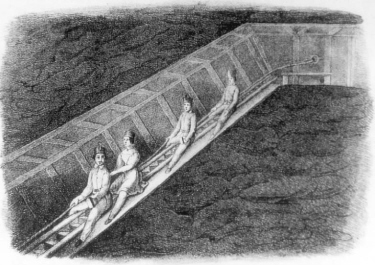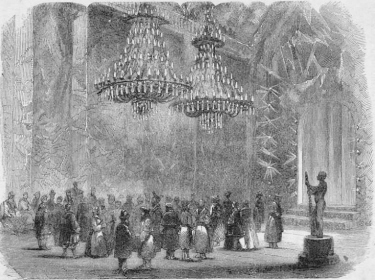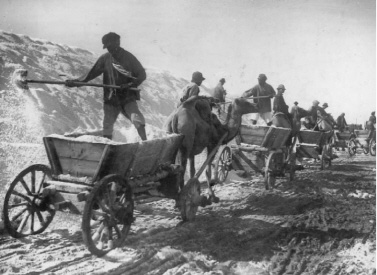Salt (26 page)


Engraving of miners descending a shaft in the Dürnberg salt mine on a slide. The rope on their right is used as a brake.
Salinen Austria, Dürnberg
Dürnberg has been hosting visitors since at least the end of the seventeenth century, when tours were a special treat for elite guests of the archbishop of Salzburg. Centuries ago it was realized that the slides could be fun. A miner at the top and five or six guests, all hugging each other, slid down as if they were in a roller coaster car. The mine also has about twenty-five underground lakes for boat rides.

M
UCH OF THE
salt of central Europe eventually came under the control of the Hapsburgs. From their beginnings in tenth-century Alsace, and as their rule spread across central Europe, the Hapsburg family controlled salt mines. In 1273, a Hapsburg became Rudolf I, king of Germany, who enlarged his holdings by conquering Bohemia. The Hapsburgs gained control of the Danube, Silesia, Hungary, and the southern region of Poland known as Galicia. For a time they even had Spain and all its New World possessions as well as the Netherlands, Naples, Sardinia, Sicily, and Venice.
The Hapsburgs established a salt monopoly, controlling production, transport, and wholesale trade. Bohemia, one of the wealthier regions of Europe, was saltless, an eager market for other Hapsburg holdings in what is today Germany, Austria, and southern Poland.
Hungary was another salt-poor region that came under Hapsburg rule. In sixteenth-century Hungary, with an economy based on the export of food, there were only four important food imports: spices, wine, herring, and salt. Much of the export of food depended on the import of salt. Pig fat was a staple for both eating and preserving other food. From the seventeenth century on, fat was included in wages. A high-fat diet was considered a sign of wealth, and city people luxuriated in more fat than peasants. An 1884 study showed that rural Hungarians ate an average per capita of forty pounds of cured—salted or smoked—fat, whereas city dwellers consumed an average per person of fifty-six pounds of fat. This does not include the significant amount of rendered animal fat that was eaten like butter, not to mention butter itself.
Cooking with melted fat rather than preserved pieces was an eighteenth-century innovation—a refinement for the upper classes. The traditional fat was made by opening a freshly slaughtered pig and removing whole the thick outer layer of fat. This was then preserved in dry salt, after which it was smoked, except in the Great Plain, the flat grain-growing region east of the Danube, where it was air-dried. Peasants made thick soups that began by melting down pieces of this salted fat, which produced an oil for frying the rest of the soup’s ingredients, and cracklings which were sprinkled on top.

S
OUTHERN POLAND WAS
the site of ancient springs where as early as 3500
B.C.
, brine was gathered and boiled in clay pots. But gradually these springs dried up. In 1247, miners began digging in the earth to get at the rock salt that had hardened at the sources of the brine. In 1278, the Polish Crown took possession of the mine but leased its operation to a succession of entrepreneurs, which included Poles, both Jewish and Christian, French, Germans, and Italians. They made payments to the controlling monarch and offered salt at discount rates to aristocracy.
At first, salt miners, often prisoners of war, were worked to death in slave conditions. Not until the fourteenth century, when free men began working the mines, did it become less than a death sentence. In the sixteenth century, the mines went deeper, and huge pulley systems powered by teams of eight horses hoisted the salt to the surface. Horses that were brought in to work the mines spent their entire lives below ground.
There are mountains in which the salt goes down very deep, particularly at Wieliczka and Bochnia. Here on the fifth of January, 1528, I climbed down fifty ladders in order to see for myself and there in the depths observed workers, naked because of the heat, using iron tools to dig out a most valuable hoard of salt from these inexhaustible mines, as if it had been gold and silver.—
Olaus Magnus,
A Description of the Northern Peoples,
1555
The Polish Crown earned one-third of its annual revenues from the salt of these two mines near Cracow, Wieliczka and Bochnia.
In 1689, the mines began offering miners daily Catholic services at their underground place-of-work. The miners of Wieliczka began carving religious figures out of rock salt. Three hundred feet below the surface, miners carved a chapel out of rock salt with statues and bas-relief scenes along the floor, walls, and ceiling. They even fashioned elaborate chandeliers from salt crystals.
Increasingly, the mine had visitors. In the early seventeenth century, as in Dürnberg, the Crown began to bring special guests, mostly royalty. They came to dance in ballrooms, dine in carved dining rooms, be rowed in underwater lagoons. In 1830, the Wieliczka Salt Mine Band, which still performs, was started because of the quality of the acoustics in the mine.
The Wieliczka mine and that of nearby Bochnia were near the Vistula, which flowed a few miles north to Cracow and then on to Warsaw and finally to the Baltic. Any salt with a water route to the Baltic had a huge market. But the Baltic port also meant that the coarse, dark gray rock salt of southern Poland had to compete with sea salt from France and Portugal. The Portuguese sold their Setúbal salt to the Hanseatics, who sold it in Holland and Denmark. By the sixteenth century, cheap, white Setúbal salt had also become popular in Poland and other Baltic countries. The Polish Crown responded by protecting its own salt with a ban on the import of all foreign sea salt.

Entertaining visitors in the Grand Hall in the Wieliczka salt mine in 1867. The walls, ceiling, floor, chandeliers, and statues are all made from salt.
Culver Pictures

I
N 1772, POLAND
was partitioned between Austria, Prussia, and Russia—vanished as a nation until after World War I. In acquiring the Galicia region, the Austrian Hapsburgs gained control of Wieliczka and Bochnia. The salt of these mines was sold not only in Poland but throughout the Hapsburg Empire and in Russia. The huge nation of Russia had a considerable demand for salt, especially to preserve meat and vegetables through a long and barren winter. Salting or corning beef in most societies was reserved for lesser cuts such as the brisket, which is the breast cut under the first five ribs, or the round, the toughest leg cut. But in Russia, beef was often frozen solid in the ground and sawed up with little regard for different cuts.

Salt being transported by camel-drawn carts to the railroad at Lake Baskuntschak, in the southern Urals of Russia, circa 1929.
Culver Pictures
The following recipe comes from
A Gift to Young Housewives,
by Elena Molokhovets. Molokhovets and her book, which she continually revised between 1861 and 1917—poignant years wedged between the emancipation of the serfs and the Communist revolution—were well known in Russian households

Other books
Rough Tumble by Keri Ford
I Choose You by Lopez, Bethany
The Monolith Murders by Lorne L. Bentley
The Hummingbird by Kati Hiekkapelto
The Darwin Awards Countdown to Extinction by Wendy Northcutt
The Take by Mike Dennis
Button, Button: Uncanny Stories by Richard Matheson
Cotton Grass Lodge by Woodbury, DeNise
A Man Without Breath (Bernie Gunther Mystery 9) by Philip Kerr
Phoenix and Ashes by Mercedes Lackey
